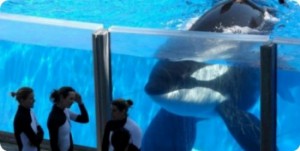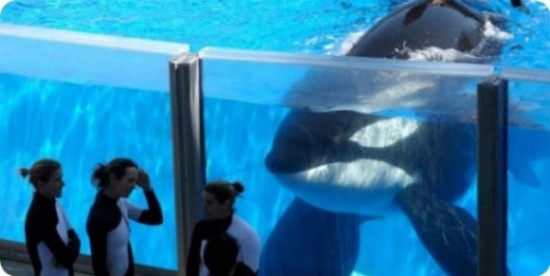The willful ignorance and glaring stupidity of the American public is ultimately was contributed to the fate of the poor sea life held hostage at Sea World. “Blackfish” is another instance of a major corporate entity lying boldfaced to their consumer and exploiting someone to make a profit. While it would be easy to completely blame Seaworld for being cruel and vicious captives of the Killer Whale species, its their customers and supporters own inability to distinguish between fact and fiction that contributed to the sheer cruelty and violence that has constantly plagued Seaworld since its inception. Seaworld has gone through decades of covering up the deaths of trainers that have fallen victim to the wrath of Orcas, all of whom have acted upon their natural predatory instinct. Seaworld also exploited the Orcas, convincing their paying public that these wild animals were capable of being tamed and transformed in to lovable beasts we can play with.
“Blackfish” is a disturbing and absolutely grueling account of the rise of seaworld and how they’ve built their empire on torturing animals all for the sake of amusement, and cashing in on the genes of a precious animal. Director Gabriela Cowperthwaite chronicles the creation and inevitable popularity of Seaworld, their seeping in to popular culture, how they managed to convince the world they were an institution devoted to helping wildlife, and how their utterly inhuman practices have become common place for their amusement parks. Most of what is described here is almost impossible to sit through, as Cowperthwaite explores the methods of chasing down, trapping, and kidnapping young orcas in the wild in order to seize them for the parks. The accounts are relayed by former hunters and trappers, all of whom explain how they snared the whales and the methods for hunting and murder they enacted. One sailor even recalls watching the mother whales line up to scream and cry as they seized baby Orcas, accounts he finishes with a teary eye and obviously wounded heart.
The practices that tame the beasts are repulsive and Cowperthwaite emphasizes the film on killer whale Tilikum, an orca taken from his mother as a baby and forced in to becoming a performance animal. Tilikum’s conditions involving starvation, isolation, abuse, punishment, and absolutely vicious training methods resulted in the animal growing in to a consistently violent beast that would inevitably end in his eating one of Seaworld’s most prominent and enthusiastic animal trainers. When Seaworld found it impossible to cover up the incident, more investigation followed making their practices become more and more exposed and inspiring protest and lawsuits aplenty. Cowpelthwaite’s “Blackfish” is long overdue, about twenty years to be exact, as she explores the incidents and deaths revolving around Seaworld and Tilikum, and the conspiracy to bury repeated reports of accidents, animal deaths, and terrible work conditions for the trainers.
Through graphic anecdotes and often brutally violent video footage, Cowpelthwaite reveals how truly aggressive these alleged cute animals are and have always been, as well as how far Seaworld has gone to cover up the deaths of their staff and lie to the audience, but how far Seaworld would go to protect their own financial assets at the costs of helpless animals. It’s also stunning how easy audiences were willing to accept their lies and bold faced deception all for the sake of transforming these wild animals in to lovable mascots. In the end it wasn’t just Seaworld that damaged this species, but the ticket buyers, mass consumerism, and lazy media, and that is what truly stings as Cowpelthwaite closes her film on Tilikum who remains a hostage and will likely die in captivity. “Blackfish” is a documentary that must be seen by audiences, and should be mandatory for wildlife lovers and advocates, so we can prevent another corrupt organization like Seaworld from ever coming to prominence again.


